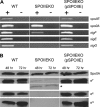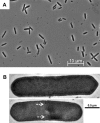SpoIIE is necessary for asymmetric division, sporulation, and expression of sigmaF, sigmaE, and sigmaG but does not control solvent production in Clostridium acetobutylicum ATCC 824
- PMID: 21784928
- PMCID: PMC3187438
- DOI: 10.1128/JB.05474-11
SpoIIE is necessary for asymmetric division, sporulation, and expression of sigmaF, sigmaE, and sigmaG but does not control solvent production in Clostridium acetobutylicum ATCC 824
Abstract
In order to better characterize the initial stages of sporulation past Spo0A activation and the associated solventogenesis in the important industrial and model organism Clostridium acetobutylicum, the spoIIE gene was successfully disrupted and its expression was silenced. By silencing spoIIE, sporulation was blocked prior to asymmetric division, and no mature spores or any distinguishable morphogenetic changes developed. Upon plasmid-based complementation of spoIIE, sporulation was restored, although the number of spores formed was below that of the plasmid control strain. To investigate the impact of silencing spoIIE on the regulation of sporulation, transcript levels of sigF, sigE, and sigG were examined by semiquantitative reverse transcription-PCR, and the corresponding σF, σE, and σG protein levels were determined by Western analysis. Expression of sigF was significantly reduced in the inactivation strain, and this resulted in very low σF protein levels. Expression of sigE was barely detected, and no sigG transcript was detected at all; consequently, no σE or σG proteins were detected. These data suggest an autostimulatory role for σF in C. acetobutylicum, in contrast to the model organism for endospore formation, Bacillus subtilis, and confirm that high-level expression of σF is required for expression of σE and σG. Unlike the σF and σE inactivation strains, the SpoIIE inactivation strain did not exhibit inoculum-dependent solvent formation and produced good levels of solvents from both exponential- and stationary-phase inocula. Thus, we concluded that SpoIIE does not control solvent formation.
Figures





References
-
- Arigoni F., Pogliano K., Webb C. D., Stragier P., Losick R. 1995. Localization of protein implicated in establishment of cell type to sites of asymmetric division. Science 270:637–640 - PubMed
-
- Barak I., et al. 1996. Structure and function of the Bacillus SpoIIE protein and its localization to sites of sporulation septum assembly. Mol. Microbiol. 19:1047–1060 - PubMed
Publication types
MeSH terms
Substances
LinkOut - more resources
Full Text Sources
Molecular Biology Databases
Miscellaneous

